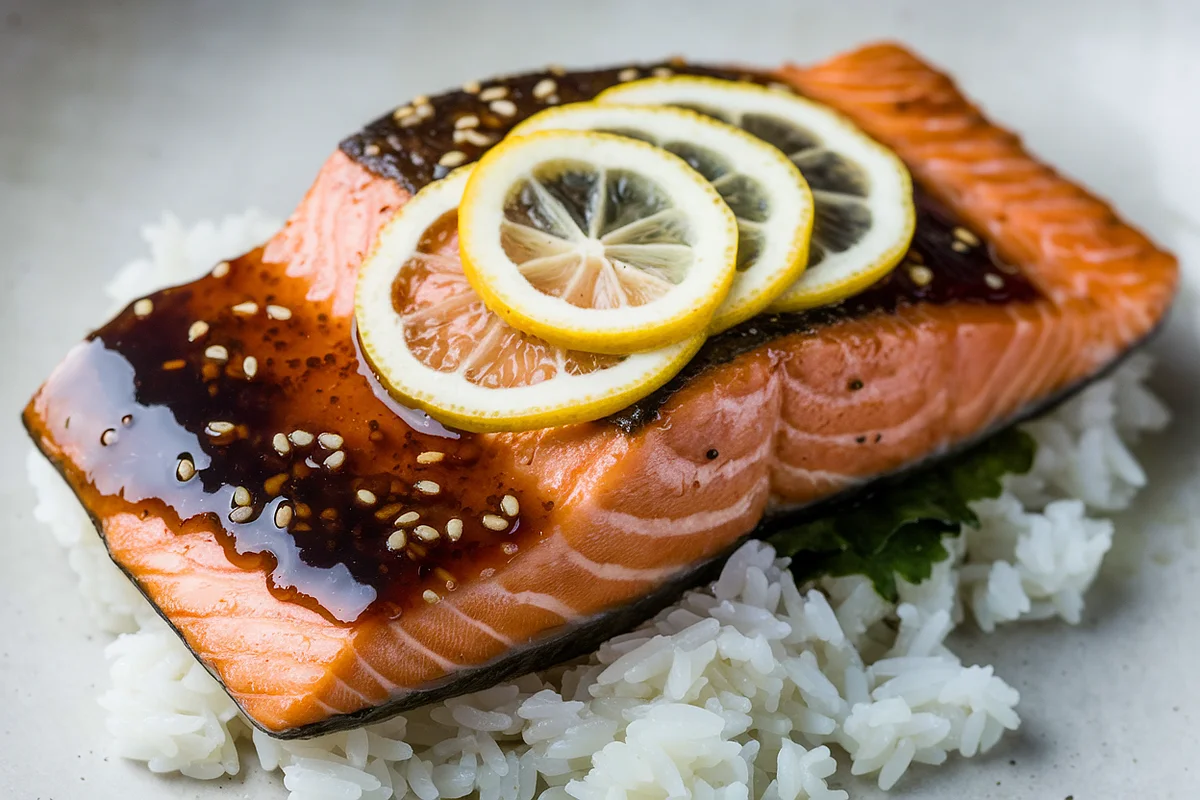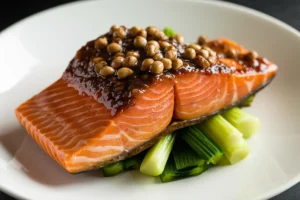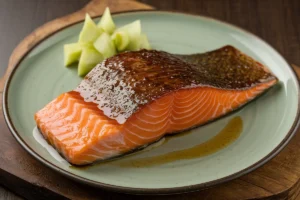Miso glazed salmon is a popular Japanese-inspired dish that marries the rich, savory flavors of miso with the natural sweetness of salmon. The result is a perfectly balanced meal that’s not only delicious but also packed with nutritional benefits. This dish has gained significant popularity for its simplicity, exquisite taste, and health advantages. Let’s dive deep into what makes this dish special and how you can easily make it at home.
What is Miso Glaze?
Miso is a traditional Japanese seasoning made from fermented soybeans. This key ingredient is what gives miso glaze its umami-rich flavor, a taste that is both savory and slightly tangy. It pairs incredibly well with fatty fish like salmon, making it a staple in many Japanese households.
There are different types of miso:
- White Miso (Shiro Miso): Sweeter and lighter in flavor.
- Red Miso (Aka Miso): Richer, saltier, and more robust in taste.
- Mixed Miso (Awase Miso): A blend of both, offering a balanced flavor profile.
The miso glaze not only enhances the natural flavor of the fish but also helps caramelize it during cooking, adding a complex and slightly sweet crust. This glaze typically includes a combination of:
- Miso paste
- Soy sauce
- Rice vinegar
- Mirin (a sweet rice wine)
- Ginger and garlic for depth of flavor
For a more comprehensive overview of miso and its nutritional benefits, you can check out this article on fermented foods.
Main Ingredients of Miso Glazed Salmon
Let’s break down the essential ingredients used in making miso glazed salmon:
1. Salmon
Salmon is a fatty, nutrient-dense fish packed with Omega-3 fatty acids, which are known for their heart-healthy benefits. When selecting salmon for this dish, you can choose between wild-caught or farm-raised varieties. Wild-caught salmon tends to have a stronger flavor and firmer texture, while farm-raised is generally more accessible and milder in taste. The most common species used in recipes include:
- King Salmon: Rich and fatty, known for its delicate flavor.
- Sockeye Salmon: Firm and flavorful.
- Atlantic Salmon: Widely available, farm-raised, and mild in flavor.
Learn more about sustainable salmon choices and their benefits by visiting this resource on seafood sustainability.
2. Miso Paste
The miso paste is the star of the dish. Depending on the flavor you’re aiming for, you can use either white or red miso. White miso is milder and sweeter, making it perfect for those new to the dish. Red miso, on the other hand, is stronger and saltier, providing a deeper flavor profile.
3. Soy Sauce
Soy sauce is another umami-rich ingredient that balances the sweetness of the glaze. It adds depth and complexity to the flavor without overpowering the fish.
4. Rice Vinegar
The acidity of rice vinegar helps cut through the richness of the salmon, adding a bright, tangy flavor that elevates the overall dish.
5. Mirin
Mirin is a type of sweet rice wine that complements the saltiness of the miso paste and soy sauce, giving the glaze a slight sweetness and sheen.
6. Ginger & Garlic
These two ingredients provide an additional layer of flavor, adding a hint of spice and earthiness that balances the savory and sweet components.
7. Sweeteners
To balance the salty and umami-rich miso, many recipes call for a sweetener. Options include:
- Honey
- Maple syrup
- Brown sugar
Each sweetener will add a different level of sweetness and caramelization to the salmon, giving you the flexibility to customize the dish to your liking.
How to Make Miso Glazed Salmon
Here’s a step-by-step guide to preparing miso glazed salmon at home.
Step 1: Preparing the Salmon
Start by selecting high-quality salmon. You can either leave the skin on (which crisps up nicely during cooking) or remove it, depending on your preference. Clean the fillets, pat them dry, and season lightly with salt.
Step 2: Creating the Miso Glaze
In a small bowl, whisk together the following ingredients:
- 2 tablespoons of white miso paste
- 1 tablespoon of soy sauce
- 1 tablespoon of rice vinegar
- 1 tablespoon of mirin
- 1 teaspoon of grated ginger
- 1 teaspoon of minced garlic
- 1 tablespoon of honey (or any sweetener of your choice)
Adjust the sweetness and saltiness to taste.
Step 3: Marinating the Salmon
Brush the miso glaze generously over each piece of salmon. Let it marinate for at least 30 minutes in the refrigerator. This allows the flavors to penetrate the fish, resulting in a more flavorful dish.
Step 4: Cooking the Salmon
You have several options when it comes to cooking miso glazed salmon:
- Broiling: This method caramelizes the glaze beautifully and cooks the salmon quickly. Place the salmon on a foil-lined baking sheet and broil for 6-8 minutes.
- Grilling: Grill the salmon on medium-high heat for 4-5 minutes on each side, ensuring the glaze doesn’t burn.
- Pan-Searing: Heat a non-stick skillet over medium heat and sear the salmon skin-side down for 5 minutes before flipping.
- Baking: Preheat your oven to 400°F and bake the salmon for 12-15 minutes until it flakes easily with a fork.
Regardless of the method you choose, make sure to avoid overcooking, as salmon can become dry and lose its natural richness.
Different Types of Salmon for Miso Glazed Salmon
There are various types of salmon, each offering a unique flavor and texture. Here are the most popular types used in miso glazed salmon recipes:
Wild-Caught Salmon vs. Farm-Raised Salmon
- Wild-Caught Salmon: Known for its richer flavor and firmer texture.
- Farm-Raised Salmon: Typically milder and fattier.
Popular Salmon Species
- King Salmon: This is the richest and fattiest type of salmon.
- Sockeye Salmon: Firm with a deep red color and robust flavor.
- Atlantic Salmon: Most widely available, especially as farm-raised.
The type of salmon you choose can significantly impact the final flavor and texture of the dish.
Variations of Miso Glazed Salmon
There are several variations of miso glazed salmon depending on the flavors and ingredients you want to experiment with:
Spicy Miso Glazed Salmon
To add a spicy kick, you can incorporate Sriracha or red pepper flakes into the glaze.
Sweet & Tangy Miso Glazed Salmon
For a sweeter variation, increase the amount of honey or maple syrup. You can also add orange juice or pineapple juice to give the dish a tropical twist.
Vegetable-Paired Miso Glazed Salmon
This dish pairs beautifully with vegetables like bok choy, asparagus, or broccoli. Roast these alongside the salmon, and the miso glaze will complement the natural sweetness of the vegetables.
Miso Glazed Salmon with Noodles or Rice
Serve the salmon over a bed of rice or noodles to make it a more filling meal. Adding sesame seeds and chopped scallions as a garnish will provide a delightful crunch and extra flavor.
Advanced Cooking Techniques
While miso glazed salmon can be simple to make, there are advanced techniques to elevate this dish to restaurant-quality:
Broiling for a Perfect Glaze
Broiling allows the miso glaze to caramelize quickly, giving the salmon a slightly charred exterior while keeping the inside moist.
Using a Cast Iron Skillet
A cast iron skillet retains heat evenly and provides a beautiful sear to the salmon, locking in the flavors of the glaze.
Sous-Vide Cooking
For perfectly tender salmon, use the sous-vide method. Vacuum-seal the marinated salmon and cook it in a water bath at a low temperature for an hour before quickly searing it in a hot pan.
Health Benefits of Miso Glazed Salmon
Miso glazed salmon is not only delicious but also incredibly nutritious. Both the salmon and miso provide a range of health benefits:
Omega-3 Fatty Acids from Salmon
Salmon is rich in Omega-3 fatty acids, which are essential for heart health. They help reduce inflammation, lower blood pressure, and improve cholesterol levels.
Fermented Foods & Gut Health
The miso paste used in the glaze is a fermented food, meaning it contains beneficial bacteria that support gut health. These probiotics can improve digestion and boost your immune system.
Protein & Essential Nutrients
Salmon is also an excellent source of lean protein, vitamins (like B12 and D), and minerals (like selenium), making it a well-rounded addition to any diet.
Common Mistakes to Avoid
When making miso glazed salmon, it’s essential to avoid these common mistakes:
- Overcooking the Salmon: Salmon is best when cooked to an internal temperature of 145°F. Overcooking can dry it out and make it less flavorful.
- Using Too Much Miso: Miso is potent, so balance it with the other ingredients in the glaze.
- Not Balancing the Glaze: Ensure the glaze has a balance of sweetness, saltiness, and acidity to enhance the salmon’s natural flavors.
- Burning the Glaze: Because of the sugar content in the glaze, it can burn quickly if cooked at too high a temperature. Monitor closely while cooking.
FAQs
Can I Substitute Other Fish for Salmon?
Yes, you can use other fatty fish like cod, black cod, or sea bass. The miso glaze works well with any fish that has a firm texture and rich flavor.
What’s the Difference Between White and Red Miso?
White miso is milder and sweeter, while red miso is saltier and has a deeper, more complex flavor. Choose based on the flavor profile you prefer.
How Long Should I Marinate the Salmon?
It’s best to marinate the salmon for at least 30 minutes, but no longer than an hour, as miso can be quite salty.
What Sides Pair Well with Miso Glazed Salmon?
Popular sides include steamed rice, noodles, or roasted vegetables like broccoli or asparagus.
Can I Make the Glaze Ahead of Time?
Yes, the miso glaze can be made up to a week in advance and stored in the refrigerator.
How Do I Store Leftovers?
Store leftover miso glazed salmon in an airtight container in the fridge for up to three days. To reheat, gently warm in the oven at a low temperature.
Serving Suggestions
Miso glazed salmon is a versatile dish that pairs well with a variety of side dishes. Here are some ideas:
- Steamed Jasmine Rice: The neutral flavor of rice balances the richness of the salmon.
- Stir-Fried Vegetables: A mix of bell peppers, broccoli, and bok choy adds color and crunch.
- Cold Noodle Salad: A refreshing option with soba noodles, cucumbers, and sesame seeds.
- Miso Soup: A traditional pairing that complements the flavors of the glaze.
Conclusion
Miso glazed salmon is a delicious, nutrient-packed dish that combines the rich, umami flavors of miso with the heart-healthy benefits of salmon. Whether you’re new to cooking fish or a seasoned chef, this dish is sure to impress. By following this comprehensive guide, you can make the perfect miso glazed salmon that’s not only flavorful but also healthy and satisfying.
Don’t forget to experiment with different miso types, cooking methods, and side dishes to make the dish your own. Enjoy!



